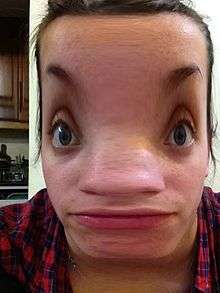Image warping

Image warping is the process of digitally manipulating an image such that any shapes portrayed in the image have been significantly distorted. Warping may be used for correcting image distortion as well as for creative purposes (e.g., morphing[1]). The same techniques are equally applicable to video.
Overview
While an image can be transformed in various ways, pure warping means that points are mapped to points without changing the colors. This can be based mathematically on any function from (part of) the plane to the plane. If the function is injective the original can be reconstructed. If the function is a bijection any image can be inversely transformed.
The following list is not meant to be a partitioning of all available methods into categories.
- Images may be distorted through simulation of optical aberrations.
- Images may be viewed as if they had been projected onto a curved or mirrored surface. (This is often seen in raytraced images.)
- Images can be partitioned into polygons and each polygon distorted.
- Images can be distorted using morphing.
There are at least two ways to generate an image using whatever chosen methods to distort.
- (forward-mapping) a given mapping from sources to images is directly applied
- (reverse-mapping) for a given mapping from sources to images, the source is found from the image
To estimate what kind of warping has taken place between consecutive images, one can use optical flow estimation techniques.
In the news
In 2007, a suspected pedophile used the "swirl" effect to hide his face in the pictures he had taken while raping and sexually abusing young children whose "ages appear to range from six to early teens."[2] Interpol trivially reversed the swirl by swirling in the opposite direction to identify and eventually locate the man in Thailand.
See also
- Anamorphosis
- Softwarp, is a software technique to warp an image so that it can be projected on a curved screen.
References
- Wolberg, G. (1990), Digital Image Warping, IEEE Computer Society Press, ISBN 0-8186-8944-7.
- ↑ Beier, Thaddeus. Feature-Based Image Metamorphosis. Siggraph '92
- ↑ Nizza, Mike (2007-10-08). "Interpol Untwirls a Suspected Pedophile". New York Times Blog. p. The Lede. Retrieved 2008-08-25.
External links
- McMillan, Leonard “An Image-Based Approach to Three-Dimensional Computer Graphics”, Dissertation, 1997